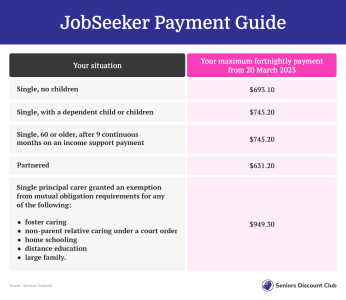JobSeeker base rate hike announced to address inflationary pressures
- Replies 60
Make no mistake about it, times are tough for countless Australians due to the rising cost of living, and people on JobSeeker are certainly not exempt from the struggle.
That is why we here at the SDC are glad to report that this sector of our society will soon benefit from a bump in their payments to help them through these difficult times.
The JobSeeker rate is set to increase by up to an additional $40 a fortnight come September after a budget boost to its base rate. Including a six-monthly indexation increase of 2.2 per cent, this means that those on the JobSeeker allowance could be receiving up to an extra $56 per fortnight once the payment increase takes full effect.
Australians on Centrelink payments, such as the single-parenting income, however, will have to wait a little longer for news on how their payments will be altered due to cost-of-living pressures.

According to Social Services Minister Amanda Rishworth, there are a few considerations yet to come into play.
'Some of the other measures like the pension and single parent payment have a choice of indexation measures,' she said, 'so we've got to work through those'.
High inflation is also being factored into these considerations, but any increase in payments must be weighed up against the budget's management.
Older Aussies who are eligible for higher JobSeeker payments can expect to receive up to $109 extra a fortnight when it kicks in in September.
With this, the federal government is also under pressure to further increase welfare payments and introduce cost-of-living assistance measures.
Though Social Services Minister Amanda Rishworth foresaw a surplus of $20 billion for the last financial year, the treasurer decided to save that money due to long-term pressures on the budget.
Rishworth said that any changes to welfare payments had to be responsible, sustainable and ongoing.
'The changes we're making—whether it's to rent assistance, JobSeeker—are structural changes; they're ongoing increases that will be applied,' she said.
'So when you talk about the surplus from last year, that's a very different circumstance to the reforms that we've made, which are ongoing. We have calibrated these to be responsible for helping people that are doing it tough, but also that they're sustainable into the long-term.'
On the other hand, the opposition plans to undo the promised $40 increase to JobSeeker payments. Instead, they suggest raising the eligibility threshold, which they said would be more beneficial to a larger number of people and may save the government money.
The new higher payment is scheduled to take effect from September 20, but it is contingent on the government's safety net bill passing the Senate.
The Coalition, however, aims to modify the bill during its Senate consideration to reverse the $40 increase. Instead, they propose raising the threshold at which benefits start to be reduced by $150 per fortnight.
Shadow Social Services Minister Michael Sukkar stated that this alternative measure would save the budget a substantial $2.9 billion over the next four years.
'There are 808,000 JobSeeker recipients across the nation, of which more than 75 per cent have zero reported earnings, with no part-time work,' Mr Sukkar said.
'Increasing the income-free area before benefits are reduced incentivises those on working age payments to take up employment opportunities.'
The opposition will attempt to convince the Senate of their proposal, but they ultimately won't stand in the way of the rate increase if it proceeds.

Members, what are your thoughts on this announcement? Let us know in the comments below!
That is why we here at the SDC are glad to report that this sector of our society will soon benefit from a bump in their payments to help them through these difficult times.
The JobSeeker rate is set to increase by up to an additional $40 a fortnight come September after a budget boost to its base rate. Including a six-monthly indexation increase of 2.2 per cent, this means that those on the JobSeeker allowance could be receiving up to an extra $56 per fortnight once the payment increase takes full effect.
Australians on Centrelink payments, such as the single-parenting income, however, will have to wait a little longer for news on how their payments will be altered due to cost-of-living pressures.

Australians on JobSeeker can expect a bump in their payments as the cost of living rises. Credit: Shutterstock.
According to Social Services Minister Amanda Rishworth, there are a few considerations yet to come into play.
'Some of the other measures like the pension and single parent payment have a choice of indexation measures,' she said, 'so we've got to work through those'.
High inflation is also being factored into these considerations, but any increase in payments must be weighed up against the budget's management.
Older Aussies who are eligible for higher JobSeeker payments can expect to receive up to $109 extra a fortnight when it kicks in in September.
With this, the federal government is also under pressure to further increase welfare payments and introduce cost-of-living assistance measures.
Though Social Services Minister Amanda Rishworth foresaw a surplus of $20 billion for the last financial year, the treasurer decided to save that money due to long-term pressures on the budget.
Rishworth said that any changes to welfare payments had to be responsible, sustainable and ongoing.
'The changes we're making—whether it's to rent assistance, JobSeeker—are structural changes; they're ongoing increases that will be applied,' she said.
'So when you talk about the surplus from last year, that's a very different circumstance to the reforms that we've made, which are ongoing. We have calibrated these to be responsible for helping people that are doing it tough, but also that they're sustainable into the long-term.'
On the other hand, the opposition plans to undo the promised $40 increase to JobSeeker payments. Instead, they suggest raising the eligibility threshold, which they said would be more beneficial to a larger number of people and may save the government money.
The new higher payment is scheduled to take effect from September 20, but it is contingent on the government's safety net bill passing the Senate.
The Coalition, however, aims to modify the bill during its Senate consideration to reverse the $40 increase. Instead, they propose raising the threshold at which benefits start to be reduced by $150 per fortnight.
Shadow Social Services Minister Michael Sukkar stated that this alternative measure would save the budget a substantial $2.9 billion over the next four years.
'There are 808,000 JobSeeker recipients across the nation, of which more than 75 per cent have zero reported earnings, with no part-time work,' Mr Sukkar said.
'Increasing the income-free area before benefits are reduced incentivises those on working age payments to take up employment opportunities.'
The opposition will attempt to convince the Senate of their proposal, but they ultimately won't stand in the way of the rate increase if it proceeds.
Key Takeaways
- Australians on JobSeeker payments can expect a rise due to inflation and a budget boost, increasing the base rate by another $40 in September.
- Recipients of other forms of Centrelink payments, like the single-parenting income, are still waiting to find out how their payments will be adjusted in light of the rising cost of living.
- Social Services Minister Amanda Rishworth stated that any considerations for welfare increase must be balanced with budget pressures and inflationary pressures.
- Despite an expected budget surplus, the government faces pressure to increase welfare payments and formulate new cost-of-living assistance measures.
- The Coalition has moved to reverse a lift to the base rate and instead lift the benefits cut-off point.
Members, what are your thoughts on this announcement? Let us know in the comments below!








